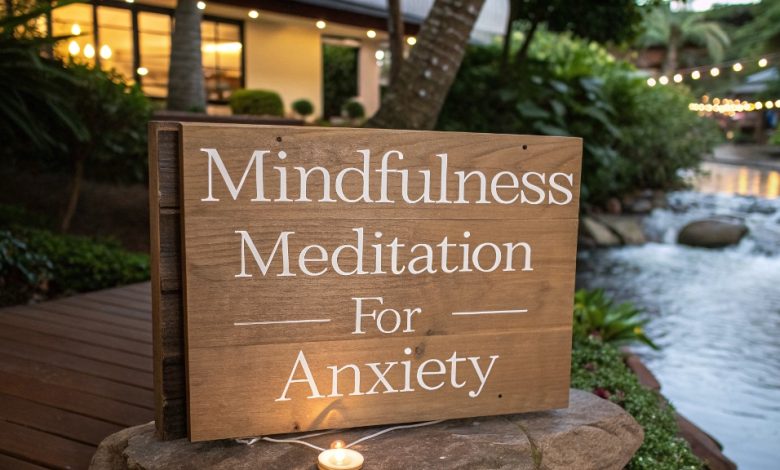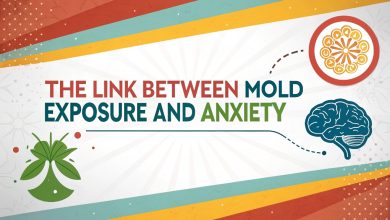Mindfulness Meditation for Anxiety

In today’s fast-paced, hyperconnected world, anxiety has become a common part of the human experience. From relentless work demands to constant digital stimulation, the pressures of modern life often leave people feeling overwhelmed, tense, and mentally exhausted. Amid growing mental health challenges, mindfulness meditation has emerged as a powerful, evidence-backed approach to managing anxiety—one that empowers individuals to respond to stress with clarity, calm, and resilience.
Understanding Anxiety: A Modern Epidemic

What Is Anxiety?
Anxiety is a natural response to stress, often characterized by feelings of worry, nervousness, or fear. While occasional anxiety is a normal part of life, chronic anxiety can interfere with daily activities and well-being. It may manifest as:
-
Generalized Anxiety Disorder (GAD)
-
Panic Disorder
-
Social Anxiety Disorder
-
Specific Phobias
The Scope of the Problem
According to the World Health Organization, anxiety disorders are the most common mental health conditions globally, affecting over 301 million people as of 2024. Anxiety is often exacerbated by:
-
Work-related stress
-
Financial insecurity
-
Social isolation
-
Overexposure to digital media
The Roots of Mindfulness Meditation
Historical Background
Mindfulness is not a modern invention. It stems from ancient contemplative traditions, particularly:
-
Buddhist Vipassana meditation: Originated over 2,500 years ago
-
Hindu Dhyana practices: Focused on cultivating mental clarity
-
Taoist and Zen influences: Emphasized present-moment awareness
Jon Kabat-Zinn popularized mindfulness in the West during the late 1970s by creating the Mindfulness-Based Stress Reduction (MBSR) program at the University of Massachusetts Medical School.
Mindfulness in the Western World
Since Kabat-Zinn’s MBSR model, mindfulness has been incorporated into:
-
Cognitive Behavioral Therapy (CBT)
-
Dialectical Behavior Therapy (DBT)
-
Acceptance and Commitment Therapy (ACT)
These integrations make mindfulness both a standalone practice and a complementary mental health strategy.
Key Concepts of Mindfulness Meditation
Defining Mindfulness
Mindfulness is the practice of paying attention to the present moment, on purpose, without judgment. Key elements include:
-
Awareness: Conscious recognition of thoughts, feelings, and surroundings
-
Acceptance: Observing without reacting or labeling
-
Non-judgment: Letting experiences unfold naturally
Types of Mindfulness Meditation
| Type | Description | Common Techniques |
|---|---|---|
| Focused Attention | Concentration on a single object (breath, mantra) | Breathing, body scan, candle gazing |
| Open Monitoring | Observing thoughts and sensations as they arise | Noting thoughts, detaching from inner dialogue |
| Loving-Kindness (Metta) | Cultivating compassion toward self and others | Sending goodwill and forgiveness |
| Movement-Based Practices | Mindfulness through movement | Walking meditation, yoga, tai chi |
How Mindfulness Meditation Helps with Anxiety
Biological and Neurological Effects
Research shows that mindfulness changes the brain’s structure and function:
-
Amygdala: Reduces activity in the brain’s fear center
-
Prefrontal Cortex: Strengthens executive functions and emotion regulation
-
Hippocampus: Enhances memory and learning capacity
These changes lead to a calmer nervous system and improved emotional control.
Psychological Benefits
Mindfulness meditation creates cognitive shifts, including:
-
Decentering: Viewing thoughts as temporary rather than identifying with them
-
Cognitive defusion: Reducing the power of intrusive thoughts
-
Improved self-awareness: Recognizing emotional patterns before escalation
Emotional and Behavioral Gains
Regular mindfulness practice leads to:
-
Reduced emotional reactivity
-
Increased resilience to stress
-
Enhanced coping skills and adaptive behaviors
-
Improved interpersonal relationships
Scientific Support
Numerous studies confirm the benefits:
-
A 2014 meta-analysis of 47 trials (JAMA Internal Medicine) found that mindfulness meditation reduces anxiety, depression, and pain.
-
A 2020 review in Frontiers in Psychology noted significant improvements in anxiety symptoms in as little as 8 weeks.
Practicing Mindfulness Meditation: A Step-by-Step Guide
Getting Started
Begin with short, consistent sessions:
-
Duration: Start with 5–10 minutes daily
-
Setting: Choose a quiet, comfortable space
-
Posture: Sit upright but relaxed
Basic Technique: Mindful Breathing
-
Sit or lie comfortably
-
Close your eyes gently
-
Bring attention to your breath
-
Notice the inhale and exhale without changing it
-
Gently return focus to the breath when the mind wanders
Expanding the Practice
-
Body Scan: Mentally scanning and relaxing each part of the body
-
Noting Practice: Labeling thoughts/emotions as they arise (“thinking,” “worrying”)
-
Walking Meditation: Focusing on the movement and sensation of each step
Challenges of Using Mindfulness for Anxiety
Common Obstacles
Even seasoned practitioners face challenges:
-
Restlessness: Anxiety can make stillness uncomfortable
-
Intrusive thoughts: May feel intensified before improvement begins
-
Impatience: Results are gradual and not instant
Misconceptions About Mindfulness
-
It’s about emptying the mind: Not true—it’s about observing the mind
-
You must meditate for hours: Short, regular sessions are effective
-
It eliminates all anxiety: Mindfulness helps manage, not eradicate, anxiety
When to Seek Professional Guidance
Mindfulness is not a cure-all. Consider seeking help when:
-
Symptoms worsen or interfere significantly with life
-
There’s a history of trauma or PTSD
-
You feel overwhelmed during or after sessions
Certified mindfulness instructors or therapists trained in mindfulness-based interventions can guide safe, effective practices.
Integrating Mindfulness into Daily Life
Micro-Moments of Mindfulness
You don’t need to be on a cushion to be mindful. Try:
-
Mindful Eating: Pay full attention to texture, taste, and chewing
-
Mindful Walking: Notice sensations in your feet, sounds around you
-
Mindful Conversations: Truly listen without planning your reply
Building a Routine
-
Pair mindfulness with existing habits (e.g., after brushing teeth)
-
Use guided apps (e.g., Headspace, Insight Timer, Calm)
-
Set reminders or use habit trackers for consistency
Journaling and Reflection
Maintain a mindfulness journal to track:
-
Duration and type of practice
-
Thoughts/emotions during meditation
-
Long-term changes in mood or anxiety levels
Real-Life Success Stories
Case Study: Sarah’s Journey with GAD
Sarah, a 34-year-old teacher, struggled with constant worry and insomnia. After joining an 8-week MBSR course:
-
She reported a 60% drop in anxiety scores
-
Slept more soundly and reacted less impulsively
-
Described feeling “present and grounded” for the first time in years
Case Study: Veteran Coping with PTSD
A U.S. Army veteran with combat-induced PTSD found relief through mindful breathing and body scans:
-
Anxiety attacks reduced in frequency
-
Could regulate emotions during flashbacks
-
Used meditation before therapy to enhance outcomes
The Future of Mindfulness Meditation
Digital Mindfulness
-
Apps and VR: Immersive meditation experiences are evolving
-
AI-based feedback: Smartwatches and apps now adapt based on biometric data
Mindfulness in Institutions
-
Schools: Integrating mindfulness to improve student focus and reduce behavioral issues
-
Workplaces: Corporate programs for stress reduction and productivity
-
Healthcare: Increasing use in pain management, oncology, and chronic illness care
Research and Innovation
Current studies explore:
-
The genetic impact of long-term mindfulness practice
-
Effects on inflammation and immune response
-
Integration with psychedelics for deeper healing in clinical settings
Read More Also: Unraveling the Root Causes of Anxiety: A Comprehensive Exploration
FAQs About Mindfulness Meditation for Anxiety
How long does it take for mindfulness meditation to reduce anxiety?
Most people notice changes within 4–8 weeks of daily practice.
Can mindfulness make anxiety worse at first?
Yes, increased awareness may bring anxiety to the surface initially. With continued practice, this usually subsides.
Is mindfulness meditation safe for everyone?
Generally, yes—but those with severe trauma histories or psychotic symptoms should consult a professional before starting.
Do I need to stop my medication to practice mindfulness?
Not at all. Mindfulness complements most medical and psychological treatments.
Read More Also: Rewiring Your Brain for Positivity: A Practical Guide to Improve Your Thinking Skills
Final Thoughts
Mindfulness meditation is not a quick fix, but it is a powerful, evidence-based tool for transforming your relationship with anxiety. Whether you’re a beginner or a seasoned practitioner, the benefits continue to unfold with regular practice. It empowers individuals not to eliminate anxiety entirely but to meet it with grace, curiosity, and inner peace.




